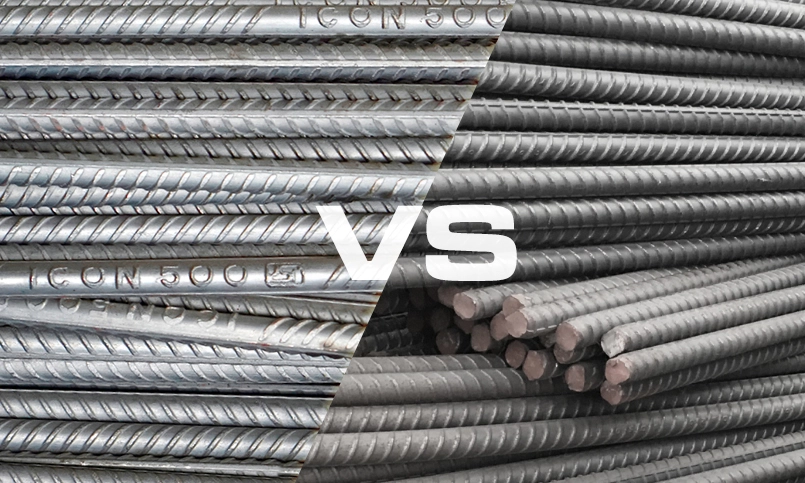When you build a house, it is not just about bricks, cement, or design. The true strength of your home comes from what holds the entire structure together—the steel rods. They act as the skeleton of your house, providing durability, strength, and safety. Among the many options available, TMT bars (thermo-mechanically treated steel) and CRS rods (corrosion-resistant steel) are the most widely used and trusted choices in residential construction. But the question many homeowners face is, which is the best for my home—TMT or CRS? Let’s explore this in detail.
Why Steel Rods Are Essential in Home Construction
Concrete by itself is very strong in compression but weak when it comes to tension. This weakness is corrected by embedding steel rods inside concrete, a combination that is known as Reinforced Cement Concrete (RCC). The steel rods provide the tensile strength that concrete lacks. This makes your home safe against external pressures such as heavy loads, wind, and even earthquakes. They also improve durability and ensure that your home lasts for decades with minimal structural damage.
Types of Steel Rods for Construction
1. TMT Bars (Thermo Mechanically Treated Steel)
TMT bars are the most widely used steel rods in India. They undergo a unique heat treatment process that makes them strong, flexible, and corrosion-resistant.
Key Benefits of TMT Bars:
- High tensile strength—ideal for modern RCC structures.
- Ductile – can bend without breaking.
- Resistant to earthquakes due to flexibility.
- Available in different grades (Fe-415, Fe-500, Fe-550, Fe-600).
- ISI/BIS certified, ensuring quality and safety.
-Best for: General residential and commercial constructions.
2. CRS Rods (Corrosion-Resistant Steel)
CRS rods are a specialized version of TMT bars that are enhanced with corrosion-resistant properties. They contain additional alloys like copper, chromium, or phosphorus, which protect the rods from rust.
Key Benefits of CRS Rods:
- Superior resistance to rust and moisture damage.
- Longer life in coastal and humid regions.
- Reduced maintenance cost over time.
- Same strength and ductility as TMT bars.
-Best for: Homes near coastal areas, river belts, or highly humid climates
TMT Bars – The Backbone of Modern Construction
TMT bars are the most popular choice for construction in India today. These rods are made using a special thermo-mechanical treatment process, which makes them extremely strong while maintaining flexibility. Their outer surface is tough, which resists wear and tear, while the inner core remains soft enough to bend without breaking. The biggest advantages of TMT bars are their strength, flexibility, and wide availability. They are manufactured in different grades like Fe-415, Fe-500, Fe-550, and Fe-600, each suited for different types of construction. For normal residential buildings, Fe-500D is usually the most recommended because it balances high strength with ductility. TMT bars are also resistant to earthquakes, which makes them ideal for regions that fall under seismic zones.
CRS Rods – The Shield Against Corrosion
While TMT bars provide strength and ductility, they may not be enough in areas where corrosion is a major problem. This is where CRS rods, or Corrosion Resistant Steel rods, come into play. CRS rods are essentially TMT bars that are treated with special alloys like copper, chromium, or phosphorus. These added elements increase their resistance to rust, making them highly durable in challenging environments. If your home is located in a coastal area, near rivers, or in regions with high humidity, CRS rods are the smarter choice. In such conditions, normal TMT bars may gradually develop rust over time, which can reduce the life of your structure. CRS rods, though slightly more expensive than TMT bars, save you money in the long run by reducing maintenance and ensuring that your home stands strong for generations.
Which One Should You Choose for Your Home?
The choice between TMT and CRS rods depends on your location and the environmental conditions surrounding your home. If you are building in a city or an inland region where the climate is moderate and humidity levels are not extreme, TMT bars are more than sufficient. They provide all the strength, flexibility, and durability required for residential buildings. On the other hand, if your plot is located close to the seashore, in areas with salty air, or in regions with very high rainfall and humidity, CRS rods are worth the investment. The added corrosion resistance ensures that your house remains structurally sound for decades without the fear of steel weakening from rust.
Grades and Selection for Home Construction
For a typical home, the most commonly used grades are Fe-500 and Fe-550. These provide the right balance of tensile strength and ductility, ensuring that your house can withstand daily loads as well as unexpected forces like earthquakes. While higher grades like Fe-600 exist, they are usually reserved for bridges, industrial buildings, and skyscrapers rather than residential houses. It is always best to consult your structural engineer before finalizing the grade of steel rods. The engineer considers soil type, building height, and design requirements before recommending the most suitable grade for your project.
Why Steel Rods Are Crucial in Home Construction?
Concrete is strong in compression but weak in tension. To balance this weakness, steel reinforcement rods are embedded inside concrete to form Reinforced Cement Concrete (RCC)
- Adds Strength: Steel rods carry tensile loads and improve overall strength.
- Durability: They help your house last longer by resisting wear and tear.
- Earthquake Resistance: High ductility prevents sudden collapse during tremors.
- Load-Bearing Capacity: Crucial for slabs, beams, and foundations.
- Without the right steel rods, even the best cement cannot guarantee a safe home.
Key Things to Keep in Mind Before Buying
- Always check for ISI or BIS certification on the rods.
- Purchase only from authorized dealers to avoid counterfeit products.
- Match the type of rod (TMT or CRS) with your location’s environmental conditions.
- Discuss with your engineer about the grade required for your house.
- Do not compromise quality for cost – remember, steel is the backbone of your home.
Conclusion
The strength and safety of your home largely depend on the steel rods you choose today. TMT bars are the ideal choice for most residential projects because of their strength, ductility, and cost-effectiveness. However, if your home is in a coastal or high-humidity region, CRS rods are the better option as they offer additional protection against rust and corrosion. In simple terms, TMT bars are the backbone, while CRS rods are the shield. Choosing the right one based on your environment ensures that your home remains strong, safe, and durable for generations to come.
https://www.livehomes.in/blogs













